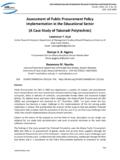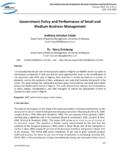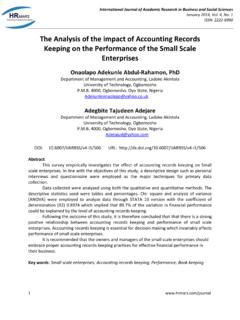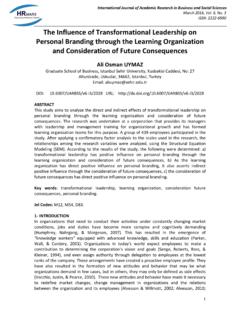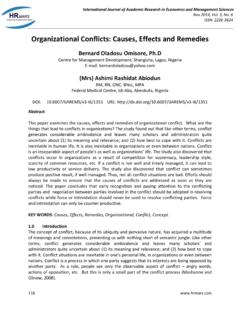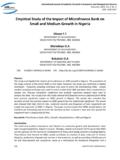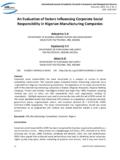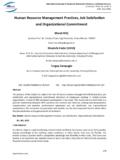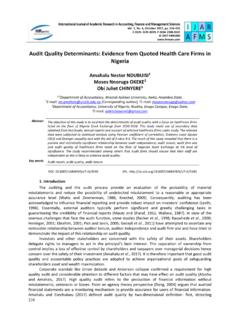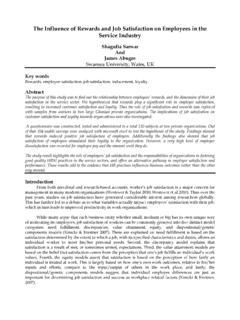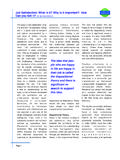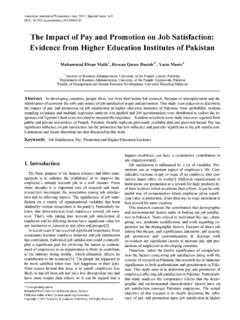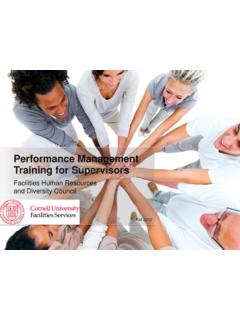Transcription of Relationship between Job Satisfaction and Job Performance ...
1 International Journal of Academic Research in Economics and Management Sciences March 2013, Vol. 2, No. 2. ISSN: 2226-3624. Relationship between Job Satisfaction and Job Performance in the Public Sector-A Case Study from India Dr. Padmakumar Ram Associate Professor, Department of Human Resource Management, Faculty of Economics and Administration, King Abdulaziz University, Box 80201, Zip Code: 21589, Jeddah, Kingdom of Saudi Arabia Email: Abstract Job Satisfaction and employee Performance is critical in a service industry like bus transport in the public sector, where about fifty percent of the costs are incurred on the procurement, maintenance, training and development of personnel. This research is an attempt to study the Relationship between overall job Satisfaction , job facet Satisfaction (14 job facets) and six measures of job Performance , with regard to the operating staff like conductors and drivers.
2 Results showed that there is no association between job facet Satisfaction and overall job Satisfaction . Out of the six measures of job Performance , for which association was tested with overall job Satisfaction , association was found only in the case of one measure viz. passenger complaints. No association was found between salary and overall job Satisfaction , in the case of low and medium income groups, whereas there is negative association in the case of high income group only. Recommendations are given and implications for future research are also discussed. Keywords: Overall Job Satisfaction , Job Facet Satisfaction , Job Performance , Tardiness, Absenteeism 1. Introduction The nature of work and other pressures in society has been changing the attitudes of people towards work itself. In this age of specialization, motivating a worker and providing him with the much needed job Satisfaction is extremely important to enable him to realize his true potential and worth to the organization.
3 It is therefore important to explain the Relationship between job Satisfaction and job Performance . Higher productivity is vital not only in manufacturing, but also in a service industry like transport. This is particularly true in the case of an essential public utility like a state bus transport service organization. Here, productivity is heavily dependent on the motivation and job Satisfaction of the operating staff of the traffic department. ie. drivers and conductors. 16 International Journal of Academic Research in Economics and Management Sciences March 2013, Vol. 2, No. 2. ISSN: 2226-3624. In spite of the tough working conditions, under which they have to operate, any slack in their Performance on account of late-coming for work, absenteeism, accidents, lack of punctuality of bus service, ,poor vehicle maintenance, passenger complaints, or other acts of indiscipline causes innumerable problems to passengers in particular, and the public in general.
4 This is because, the thousands of buses that they operate with a daily carrying capacity of about 7. million passengers, are the only affordable means of public road transportation available for the average person. There is a common feeling that a proactive human resources policy through proper reinforcement of workers, by means of implementation of various productivity linked schemes, suggestion schemes, workers participation in management, quick disposal of grievances, counseling and provision of good working conditions, welfare facilities etc. would help maintain a satisfied and productive work force, better quality of service and industrial peace, with its consequent benefits. 2. Review of Literature The Relationship between job Satisfaction and job Performance has been of great interest to researchers for a very long time. The Hawthorne studies and the subsequent human relations movement sanctified the search for the Relationship .
5 Brayfield and Crockett (1955) concluded that no appreciable Relationship existed between the two. On the other hand, Herzberg, Mausner, Peterson and Chapwell (1957) concluded that there was a systematic Relationship between job Satisfaction and certain work behaviors as well as between job dissatisfaction and other work behaviors. Two decades later Locke (1976), conducted an extensive review of the Satisfaction literature and concluded that job Satisfaction has no direct effect on productivity'. Job Satisfaction is a pleasurable or positive emotional state that arises when people appraise their job or job experiences (Locke, 1976). Implicit in Locke's definition is the importance of both affect, or feeling, and cognition, or thinking. Of all the major job Satisfaction areas, Satisfaction with the nature of the work itself which includes job challenge, autonomy, variety, and scope best predicts overall job Satisfaction , as well as other important outcomes like employee retention ( , Fried & Ferris, 1987; Parisi & Weiner, 1999).
6 There is an important difference between the earlier conceptions of the Satisfaction - Performance Relationship , and some subsequent findings. In the beginning, researchers attempted to show that Satisfaction caused productivity. But later the opposite Relationship was suggested. viz. good Performance causes Satisfaction (Locke, 1970; Porter & Lawler, 1968). Thus, to understand what causes people to be satisfied with their jobs, the nature of the work itself is one of the first places for practitioners to focus on. Many studies have shown that dissatisfied employees are more likely to quit their jobs or be absent, as compared with satisfied employees ( , Hackett & Guion, 1985; Hulin, Roznowski, & Hachiya, 1985; Kohler & Mathieu, 1993). Job Satisfaction has been studied both as an independent and dependant variable. As a dependent variable, the degree of Satisfaction has been correlated with gender, age, intelligence, race, education and various personality traits.
7 As an independent variable, it has been correlated with productivity, absenteeism, accidents and turnover. But the pattern of correlation in these studies is highly diverse in nature. 17 International Journal of Academic Research in Economics and Management Sciences March 2013, Vol. 2, No. 2. ISSN: 2226-3624. 3. Objective and Scope of the Study The basic objective of this research is to determine the extent to which Overall Job Satisfaction , Job Facet Satisfaction and Job Performance are associated in the case of the stratified sample of employees from the Transport Section (Traffic Department), drawn from two selected Bus Depots of a public road transport undertaking in India in is a case study of only the Transport section (Traffic Department).It particularly deals with the bus operating staff ie. drivers and conductors because it was found that these two categories constitute about 70. percent of the total number of employees in this organization.
8 4. Null Hypothesis Null Hypothesis 1. There is no association between Job Facet Satisfaction ( ) and Overall Job Satisfaction ( ). Null Hypothesis 2. There is no association between Age and Overall Job Satisfaction ( ). Null Hypothesis 3. There is no association between Salary and Overall Job Satisfaction ( ). Null Hypothesis 4. There is no association between Experience and Overall Job Satisfaction . Null Hypothesis 5. There is no association between Overall Job Satisfaction ( ) and each of the following six measures of Overall Job Performance ( ). (a) Productivity Bonus Earned (b) Leaves Taken Record (c) Attendance (Absenteeism and Late coming) Record (d) Passenger Complaints Record (e) Punishments (due to other reasons) Record (f) Accidents Record Null Hypothesis 6. There is no association between Job Categories and the Causes of Tardiness /Absenteeism. Null Hypothesis 7. There is no significant difference in the mean test scores of Overall Job Satisfaction ( ).
9 between the two Job Categories viz. conductors and drivers. 18 International Journal of Academic Research in Economics and Management Sciences March 2013, Vol. 2, No. 2. ISSN: 2226-3624. 5. Research Methodology The study is divided into the following two parts: Part A. The present study is a combination of the descriptive as well as non-experimental hypothesis testing methods. Having considered the importance of job Satisfaction and Performance for bus conductors and drivers, it was decided to undertake a study, and a questionnaire was developed for this purpose on the basis of a survey of the literature. This was then translated into the local language (Marathi) by a language expert, because it was felt that the respondents may have difficulty in understanding English. After initial pilot testing, and subsequent revision, final data was collected on the basis of a questionnaire consisting of 31 statements.
10 Ie. 14 for testing Job Facet Satisfaction , 5 for testing Overall Job Satisfaction , and 12 for testing causes of Tardiness and Absenteeism. Initially questionnaires were sent out to 138 employees (conductors and drivers only), out of which 85 employees (45 conductors and 40 drivers). responded. It was decided to directly contact each respondent individually and secure his opinion, after explaining the objectives of the study, and reassuring them that their responses would be kept confidential. Such direct contact with the respondent helped in clarifying any questions and in seeking necessary explanation. Respondents were interviewed individually (after they filled out the questionnaire) at their work places, during their rest hours with the prior permission of the concerned authorities. The minimum experience requirement for employees required to participate in this study was at least one year. Respondents were drawn from two bus depots on a stratified sample basis.
